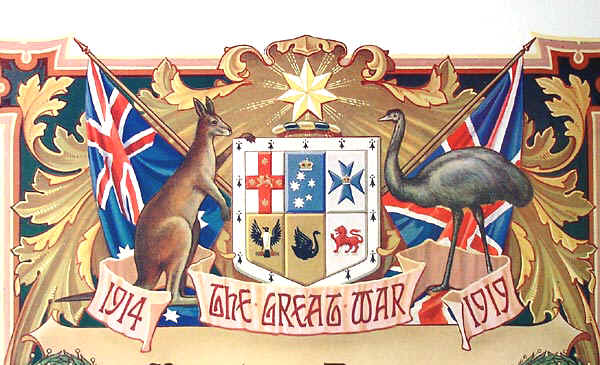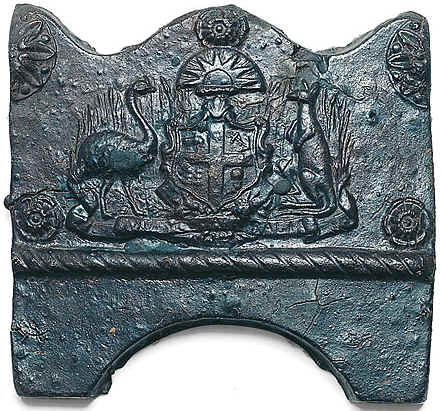| The Australian Coat of
Arms is the property of the Commonwealth of Australia and is used by the
Commonwealth to authenticate documents, to indicate ownership of
property, and for other purposes of identification. It may not be used
or reproduced by others for other purposes without permission.
The first grant of armorial ensigns,
crest and supporters to the Commonwealth of Australia was made in 1908;
a new design was granted by Royal
Warrant in 1912.
 |
|
The Coat of Arms
as used on a WW1 Certificate of Service |
 |
A garden edging tile
circa 1900 which bears a design very similar to the Coat of Arms.
Some people claim that the
Rising Sun depicted is the fore-runner to the AIF Rising Sun
badge.
|
The Commonwealth Arms are commonly but
incorrectly referred to as the 'Commonwealth Crest'. Strictly the Crest
is the device above shield and helmet on a coat of arms; in Australia's
case it is the seven-pointed gold star on the wreath.
The Australian Coat of Arms consists
of:
The Badges of the six States of the
Commonwealth arranged on a shield in two rows of three columns:

|
- New South Wales
- Golden Lion passant (right to left) on a red St George's Cross on
a silver background (usually depicted white), with an 8-pointed star
on each extremity of the cross.
|

|
- Victoria -
White Southern Cross (one star of 8 points, 2 of 7 points one of 6
points and one of 5 points), beneath an Imperial Crown, on a blue
background.
|

|
- Queensland
- light blue Maltese Cross with an Imperial Crown at its Centre, on
a white background.
|

|
- South Australia
- the White-Backed Magpie (or Piping Shrike), erect, wings
outstretched, on a yellow background.
|

|
- Western Australia
- Black Swan swimming, left to right, on a yellow background.
|

|
- Tasmania
- Red Lion passant (right to left) on a white background.
|
The shield is enclosed by an ermine
border, signifying the federation of the States into the Commonwealth.
- The Crest of the Arms, consisting
of a seven-pointed gold star on a blue and gold wreath. Six points
represent each of the States of the Commonwealth, the seventh point
represents the Commonwealth Territories.
- The Supporters of the Coat of Arms,
Australian endemic Fauna: the Kangaroo proper to the left and the
Emu proper to the right.
- Usually the Arms are depicted in a
compartment adorned with wattle (Acacia pycnantha) leaves and
inflorescence, and a scroll with the word "AUSTRALIA"
on it under the Arms. The
wattle and the scroll and the rests for the Kangaroo and Emu do not
constitute part of the Arms.
|